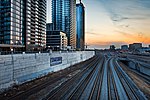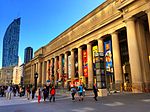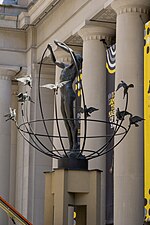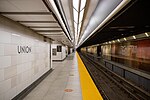Scotiabank Arena (French: Aréna Scotiabank), formerly known as Air Canada Centre (ACC), is a multi-purposed arena located on Bay Street in the South Core district of Downtown Toronto, Ontario, Canada. It is the home of the Toronto Raptors of the National Basketball Association (NBA) and the Toronto Maple Leafs of the National Hockey League (NHL). In addition, the minor league Toronto Marlies of the American Hockey League (AHL) and the Raptors 905 of the NBA G League play occasional games at the arena. The arena was previously home to the Toronto Phantoms of the Arena Football League (AFL) and the Toronto Rock of the National Lacrosse League. Scotiabank Arena also hosts other events, such as concerts, political conventions and video game competitions.
The arena is 61,780.5 square metres (665,000 sq ft) in size. It is owned and operated by Maple Leaf Sports & Entertainment Ltd. (MLSE), which also owns the Leafs and the Raptors, as well as their respective development teams.
The building was constructed in 1941 as the Toronto Postal Delivery Building for postal deliveries and was temporarily used by the Department of National Defence during World War II. After the war, the building was transferred to Canada Post in 1946 where it functioned as the main postal terminal for Metropolitan Toronto until 1989 when Canada Post moved its services to the Eastern Avenue facility. The Postal Building was sold to a consortium of developers but was reverted to Canada Post ownership in 1993 due to financial woes, but the new ownership of the soon-to-be Toronto Raptors basketball team acquired the building in December 1994 to construct the new arena. However, the Raptors were acquired by Maple Leaf Gardens Ltd., the owners of the Maple Leafs hockey team in 1998 during construction that began a year prior, to replace their outdated Maple Leaf Gardens arena. The arena was opened on February 19, 1999, at the cost of $288 million ($499 million as of 2022), with the Leafs playing the Montreal Canadiens the following night, and the Raptors playing the Vancouver Grizzlies the night after that.In 2018, Scotiabank Arena was the 13th busiest arena in the world and the busiest in Canada. It is also the most photographed location in Canada on Instagram according to BuzzFeed. Scotiabank Arena is connected to Union Station's railway, subway and regional bus services and is connected to the Path.











